Western Digital Expands HGST Helium Drive Lineup with 10TB Ultrastar He10
by Ganesh T S on December 2, 2015 3:01 AM EST- Posted in
- Enterprise
- Storage
- HDDs
- Western Digital
- HGST
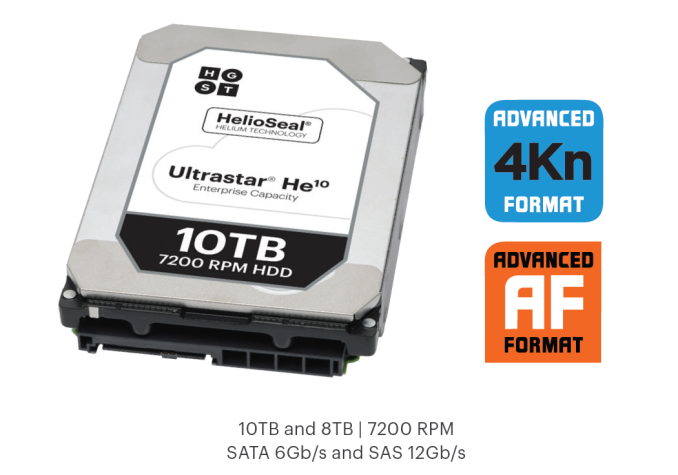
HGST, a Western Digital subsidiary, has been shipping hard drives sealed with helium for a couple of years now. Their helium drives have so far come in two flavors - the Ultrastar He drives using platters with traditional perpendicular magnetic recording (PMR) technology and the Ultrastar Archive Ha drives using platters with shingled magnetic recording (SMR). There are two main patented innovations behind the helium drives, HelioSeal and 7Stac. The former refers to placement of the platters in a hermetically sealed enclosure filled with helium instead of air. The latter refers to packaging of seven platters in the same 1" high form factor of traditional 3.5" drives.
The Ultrastar He6 6TB drive was introduced in November 2013, and this was followed by the He8 8TB drive late last year. In June 2015, the Ultrastar Ha10 SMR drive with HelioSeal technology was introduced. Around the same time, HGST also made it known that more than 1M HelioSeal units had been deployed. 1.33 TB platters have become available in air drives now, and HGST is taking advantage of that in the 10TB Ultrastar He10. The launch of the Ultrastar He10 PMR drive today also brings the news that more than 4M HelioSeal units have been deployed in various datacenters - pointing to the rapid rise in adoption rate of this technology.
We have already seen in our reviews that the helium drives offer the best performance to power ratio and watts per TB metric amongst all the drives in their capacity class. HGST also claim a 2.5M hour MTBF - much higher than traditional enterprise PMR drives. The initial cost of the helium drives have been substantially higher compared to the standard drives of the same capacity, but the TCO (total cost of ownership) metric is highly in favor of these drives - particularly for datacenter customers who need the drives to be active 24x7. HGST's press briefing included a slide that presented the potential TCO benefits that come about due to the increased capacity per rack, lower consumption per rack and lower power consumption per TB of the new He10 drives.
HGST indicated that the ramp in volume should help the initial cost to approach that of the air drives in the near future. For datacenter customers, that would mean an acceleration in obtaining the TCO benefits.
Coming to the core specifications, the Ultrastar He10 will come in both SATA 6Gbps and SAS 12Gbps varieties. The drives have 4KB sectors, though SKUs with 512-byte emulation are also available. Various data security options such as instant secure erase, self-encryption, secure erase and TCG encryption with FIPS are available.
The standard Ultrastar He drive features such as rotational vibration safeguard (for better RV tolerance in multi-drive servers) and the rebuild assist mode (for faster RAID rebuild) are retained. The drives come with a 256MB DRAM buffer.
Hard drives are struggling to reach the 10TB capacity point with traditional PMR technology. While Seagate did announce a few 8TB PMR drives earlier this quarter, it really looks like vendors need to move to some other technology (shingled magnetic recording or heat-assisted magnetic recording (HAMR)) in order to keep the $/TB metric competitive against the upcoming high-capacity SSDs. As of now, helium seems to be the only proven solution causing minimal performance impact and HGST appears to have a strong hold in this particular market segment.


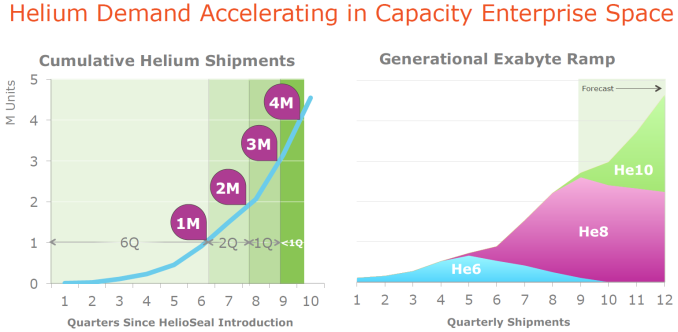
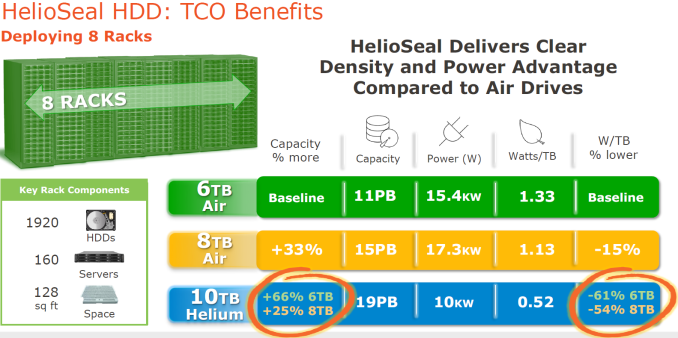
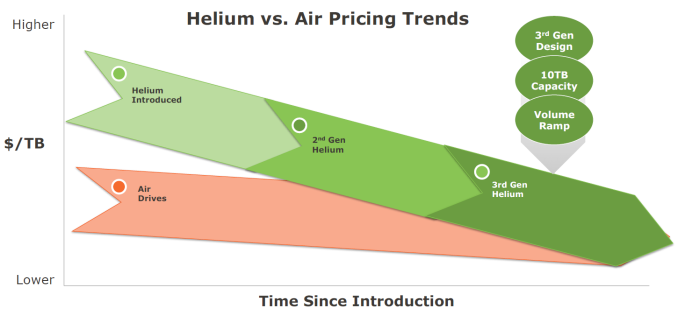
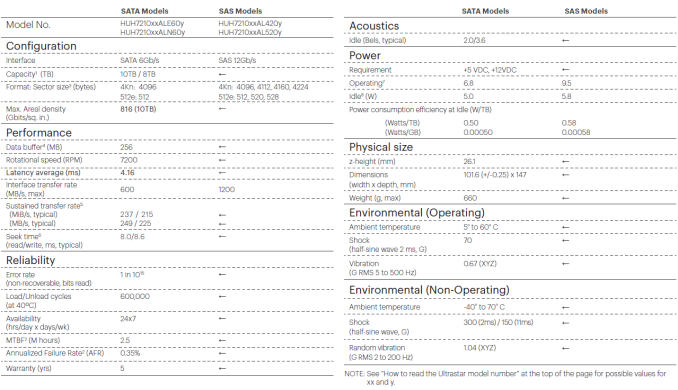
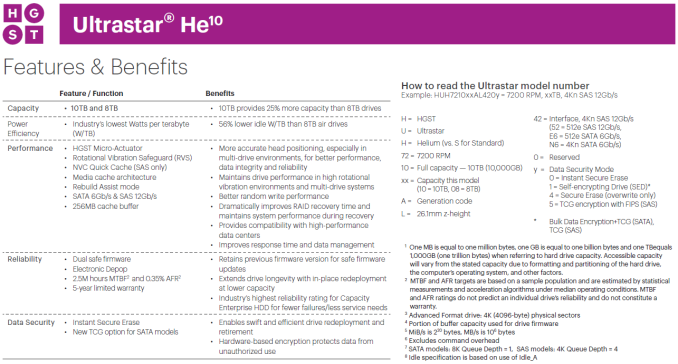








113 Comments
View All Comments
close - Monday, December 7, 2015 - link
weissPC, give it up. The guy knows sh*t about engineering (motors, circuits, firmware, interfaces, you name it) or business. He just thought it was a cool idea and now won't back out because he went too far with the crap. I gave him the benefit of the doubt and asked him to support his claims with real data, not some more "quotes from ddriver" and he failed so every single time.He just came up with some bullsh*t figures that he can't substantiate and every time someone proves him wrong he just hides inside his "reality blurring machine" and thinks that only he has facts and everyone else has suppositions, assumptions, speculation, maybes. I asked him for any paper to support his claim. He managed to write a full page of crap but no actual link to what I asked.
So basically the only argument used to support his claims is "because I say so". He's a troll on Anandtech for at least some years. Don't waste too much time, you won't get anything good. He's had years to show that and failed.
weissPC - Tuesday, December 8, 2015 - link
@close, spot on, couldn't have said it better. Better spend my time of more productive stuff. If he's that good, let him produce a real product to prove us wrong.shodanshok - Wednesday, December 2, 2015 - link
You forget that 5.2" platters existed - and they go extinct for the reason I explained above. The Quantum Bigfoot drive (a 5.25" one) was universally remember for it's very slow speed (~ 4000 RPM and very high seek time), rather than it's capacity.Earlier, 8 inch disks had the same fate - they where abandoned in favor of 5.25" disks.
There is a reason the industry standardized on cheap 3.5" for raw capacity and 2.5" for performance; however, recent 4 TB 2.5" disks are challenging that (consider that you can fit 2x2.5" disks in the same space as 1x3.5" disk).
For the multiple head counts: did you ever ask why current multi-platter, multi-head disk read from a single platter at a time, rather that striping on multiple platters? The reason is simple: with high platter density, each head must be place independently, with dedicated actuator. This will greatly increase disk cost and weight, giving only minor benefits. Please consider that such disks existed - and they got extinct for a reason.
jabber - Wednesday, December 2, 2015 - link
For spinning- smaller is better, not larger.ddriver - Wednesday, December 2, 2015 - link
There is a trade off, as you see, most HDDs are 3.5 inch devices, so obviosly, smaller is not better, there is a sweet spot. 5.25 inch HDDs will run at lower RPM, but using higher head count, they can easily and vastly outperform a traditional 3.5 inch HDD even if it spins faster. Today such components can be mass manufactured at a very low cost, and chips are advanced enough to be able to run the much more sophisticated firmware which a drive with multiple independent heads would require. Both of those were not technologically possible in the past, but today they are.jabber - Wednesday, December 2, 2015 - link
I think the market and the HDD manufacturers possibly know what they are doing and the physics involved. If it was a good idea and there was a market for it we would have them.ddriver - Wednesday, December 2, 2015 - link
If they can make money on selling you straw, why should they bother selling you wheat? They don't care about making hard drives, all they care about is profit, making hard drives is just the means to attain profit. Their priority is making as much profit as possible by selling you as little value as possible - thus maximizing the profit margin.BurntMyBacon - Wednesday, December 2, 2015 - link
@ddriver: "Their priority is making as much profit as possible by selling you as little value as possible - thus maximizing the profit margin."Accept that the HDD market is a competitive market with more than one player. To get your money, they have to at least convince their target market that they are a better value than their competitors. Case in point is the Helium tech HGST is using to get a leg up on the competition. It is MORE expensive to build than the competition, so clearly not beneficial to their margins. It does, however, provide an advantage for its cost.
Given that SSDs are (apparently) threatening to make HDDs irrelevant due to superior performance and approaching capacities, I'd say the HDD manufacturers aren't in a position to hold back anyways. If they could "have a 40 TB drive that can easily push 5-6 GB per second transfers" as you posted above, I'm pretty sure they would have done it as soon as they could have to squash any reason to pursue SSD tech which looses them a lot more than they could possibly gain by holding out on us. The 5.25" form factor is a pretty well known quantity. Sure we could do better than they did with the bigfoot drives, but the tolerances will still necessarily be looser than the smaller drives.
On the other hand, if you a better understanding of it than the current HDD manufacturers and are convinced that it can be done to great effect, then by all means, launch a kickstarter and start pushing these puppies out. I'd love to see the look on their faces if such an event were to occur.
ddriver - Wednesday, December 2, 2015 - link
"Accept that the HDD market is a competitive market with more than one player."Seems like this has become significantly less true the last several years. Today they are practically 4 - WD, Seagate, HGST and Toshiba. And they don't seem to be in a competitive spree, as the HDD technology is almost on hold, very low priority, barely any improvements, usually minor stuff, nothing ground breaking (just look at HGST - now basically the same thing, but we're gonna fill it with helium), and it is not like there's no headroom for improvement. 4 manufacturers on a planet with 7 billion people, enough business for everyone, no need to shift paradigms, better keep on price fixing and have a sweet time milking the market.
"
"On the other hand, if you a better understanding of it than the current HDD manufacturers and are convinced that it can be done to great effect, then by all means, launch a kickstarter"
That activates my hilarity unit, a HDD factory, capable of producing most components in-house will cost at least a billion. That's a little too much for kickstarter, don't you think?
xthetenth - Wednesday, December 2, 2015 - link
They're competing with SSDs. It's kind of blatantly obvious.